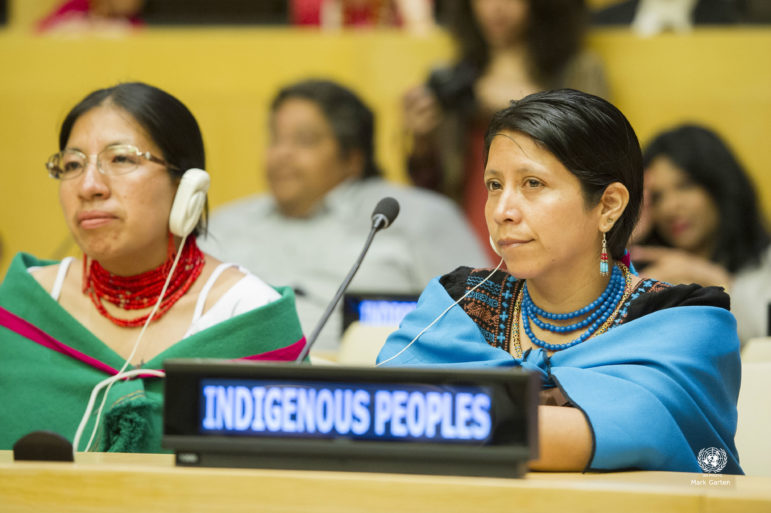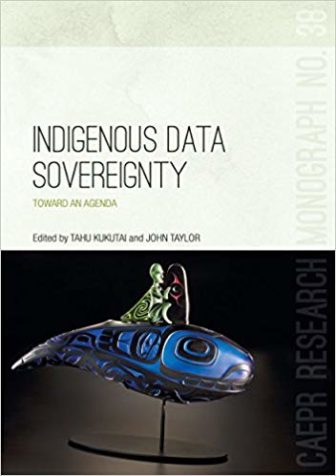He whenua hou, Te Ao Raraunga Te Ao Raraunga, He whenua hou
In Maori that phrase means, “Data is a new world, a world of opportunity.”
For Indigenous peoples worldwide, the lack of good data about their communities and their limited control over the collection and use of the data have serious consequences. The lack of reliable and consistent data results in a paucity of evidence-based Indigenous policy-making.
This GIJN/NAJA guide explores what investigative opportunities exist for journalists regarding the bundle of issues known as “Indigenous data sovereignty.”
Although this topic may sound philosophical and ethereal, the real-world ramifications are significant, affecting the creation of policies and the dispersal of funds.

Photo: UN Photo/Rick Bajornas
Background
Indigenous data sovereignty (IDS) issues are multifaceted. IDS involves several elements derived from the right of self-determination:
- The right to govern the collection of data, such as who is to be counted, so that the data reflects the interests and priorities of Indigenous people.
- The right to determine who has access to the data and how it can be used.
In practice, there are two primary problems:
- Limited control over data collection decisions.
- Widespread data gaps mean communities lack enough information to analyze and solve problems.
“The absence or lack of data that reflect where and how many Indigenous peoples there are, and how they are faring in relation to the realization of their individual and collective rights is directly related to the weakness of governments and intergovernmental bodies in formulating and implementing Indigenous-sensitive decisions and programs,” wrote Victoria Tauli-Corpuz, UN Special Rapporteur on the Rights of Indigenous Peoples, in a preface to the 2016 book Indigenous Data Sovereignty: Toward an Agenda.
 The Special Rapporteur said that beside a lack of government data-gathering resources, there’s an “unfounded fear” that disaggregated information — showing information about small segments of the larger population — could exacerbate discrimination.
The Special Rapporteur said that beside a lack of government data-gathering resources, there’s an “unfounded fear” that disaggregated information — showing information about small segments of the larger population — could exacerbate discrimination.
The main goals for Indigenous data sovereignty are spelled out by Diane E. Smith, senior research fellow and convenor of the Higher Degree by Research Program at The Australian National University’s National Centre for Indigenous Studies, in her chapter in Indigenous Data Sovereignty: Toward an Agenda. “To govern for the future,” she wrote, “Indigenous people are looking for what I would call ‘culture-smart’ data — that is, information that can be produced locally, captures local social units, conditions, priorities and concerns, and is culturally informed and meaningful.”
According to Smith, “Culture-smart data have greater potential to mobilize support and mandate from group members, to boost accountability and legitimacy and to improve the quality of actual service delivery — all of which are fundamental ingredients in the practical exercise of sovereignty.”
For a good overview, with information on many countries, see the chapter on IDS in The State of Open Data, a 2019 publication of the Open Data for Development (OD4D) Network.
Problems in Accessing Data
Most countries break down data based on sex and age, but not on Indigenous identity or ethnicity. As a result, the situation of Indigenous people often gets hidden in national averages.
On the international front, this controversy has been highlighted because the tools to measure progress on the UN’s Sustainable Developments Goals (SDGs) so far do not include measurement of Indigenous communities.
A good introduction to the SDG debate is in the 2017 report Leaving No One Behind, subtitled “Practical Guide for Indigenous Peoples,” by the Asia Indigenous Peoples Pact based in Thailand.
Also see Visibility of Indigenous Peoples in Sustainable Development Indicators, a 2018 report prepared for the 16th Conference of the International Association of Official Statisticians (IAOS) by Richard Madden and Clare Coleman, both of the Sydney Centre for Aboriginal and Torres Strait Islander Statistics – University of Sydney.
The authors graphically point out the need for more granular data. The government of Australia, they write, can claim to have met the SDG health goals despite the fact that Indigenous people in Australia have much higher rates of HIV infection (twice the rate), tuberculosis (six times higher), and other sexually transmitted diseases (nearly seven times higher) than non-Indigenous Australians.
A much-debated goal is to get detailed data, known as “disaggregated” data, from national surveys and censuses, which typically do not obtain the necessary level of detail.
In the absence of good official data, groups have undertaken participatory community-based data collection efforts, sometimes called “complementary national indicators.”
An overview on the lack of data in the US and the potential for community-based data efforts is provided by Malia Villegas, an enrolled member of the Native Village of Afognak in Alaska, in her contribution to the 2017 book Handbook of Indigenous Education.
Opportunities
Where are the opportunities for reporting?
Here are a few of the big questions that may spark inquiry:
- What is the adequacy of official statistics in relationship to the needs of Indigenous persons?
- What barriers exist to getting more granular data? Financial? Technical?
- Do Indigenous communities lack control over existing data?
- What are the practical effects of data gaps?
- How do government agencies use existing data?
- Could disaggregated data have unwanted side effects, such as exacerbating discrimination or violating personal privacy?
- Could the lack of disaggregated data negatively impact smaller communities whose special problems no longer surface?
Sources
Debates about the Indigenous data ecosystem play out at international, national, and subnational levels.
Relevant data may be generated and held by many entities: Indigenous communities and organizations; local, state, and national governments; international governmental organizations; nongovernmental organizations; research institutions; and commercial entities.
Looking for what data exists would be one starting point. Studying official processes of devising questionnaires could be instructive.
Another point of entry is to ask what data is missing. For this, it may be instructive to talk with those who could use better data, such as social service agencies, health providers, academics, and others. What gaps do they see?
Resources
There are specialists on Indigenous data sovereignty:
United States
US Indigenous Data Sovereignty Network, formed in 2016, helps ensure that data for and about Indigenous nations and peoples in the US (American Indians, Alaska Natives, and Native Hawaiians) are utilized to advance Indigenous aspirations for collective and individual well-being. USIDSN’s primary function is to provide research information and policy advocacy to safeguard the rights and promote the interests of Indigenous nations and peoples in relation to data. Look under “Resources” for other North American groups.
The National Congress of American Indians has data-related resources on its website, including a page on Using Science to Build Tribal Capacity for Data-Intensive Research. Among other things, see a 2018 report assessing The State of Tribal Data Capacity in Indian Country.
US Tribal Research
The Tribal Nations Research Group promotes research relevant to the Turtle Mountain Band of Chippewa Indians. “The research results provide custom-fit data and data ownership, promote public and private economic development and opportunity, and uphold positive images of Turtle Mountain Band of Chippewa Indians.”
The Swinomish Indian Tribal Community has a project called Indigenous Health Indicators that aims to create and test a set of community-based indicators of Indigenous health specific to Native American tribal communities in the Puget Sound/Salish Sea region of the Pacific Northwest.
Canada
First Nations Information Centre: See page on OCAP, an acronym standing for Ownership, Control, Access, and Possession.
British Columbia First Nations’ Data Governance Initiative (BCFNDGI) is an initiative “to equip First Nations with the technological and human resource capacity to govern and own their communities’ data.” See especially a 2017 Discussion Paper by Marcia Nickerson, First Nations Data Governance: Measuring the Nation to Nation Relationship (PDF).
 New Zealand
New Zealand
Te Mana Raraunga Maori Data Sovereignty Network: In New Zealand, the Māori Data Sovereignty Network, Te Mana Raraunga (TMR), has developed “a charter that provides the most complete expression to date of the basis for Indigenous data sovereignty.”
Australia
The Maiam nayri Wingara Aboriginal and Torres Strait Islander Data Sovereignty Collective was formed in early 2017 in order to develop Aboriginal and Torres Strait Islander data sovereignty principles and to identify Aboriginal and Torres Strait Islander strategic data assets.
International
International Indigenous Data Sovereignty Interest Group is sponsored by The Research Data Alliance (RDA), a “community-driven initiative” launched in 2013 by the European Commission, the US government’s National Science Foundation and National Institute of Standards and Technology, and the Australian Government’s Department of Innovation, “with the goal of building the social and technical infrastructure to enable open sharing and re-use of data.” See a 2017 Charter Statement.
The Indigenous Navigator provides an avenue for Indigenous peoples to generate quality data to document and communicate their particular situation. For example, in Bangladesh, 26 communities have completed and published the quantitative portions of their surveys, with a national survey again providing a comparison point. This page is a useful starting point, describing the connection with the Sustainable Development Goals.
The Indigenous Peoples’ Major Group for Sustainable Development is an advocacy voice on a variety of issues, including the SDGs, coordinated by Tebtebba Foundation (Indigenous Peoples International Centre for Policy Research and Education) and the International Indian Treaty Council (IITC). The site includes resources and an active news aggregation, such as a position paper on proposed SDG indicators.
The UN Permanent Forum on Indigenous Issues is a high-level advisory body to the Economic and Social Council. The site contains much background information and news about the forum’s meetings.